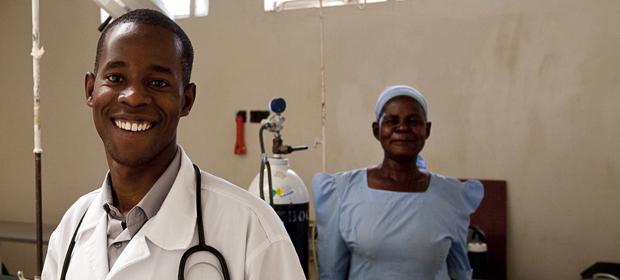Where We Work
See our interactive map


Last month, the International Journal for Equity in Health published an article written by an IntraHealth International-led research team that highlights the absence of men in the HIV/AIDS caregiving workforce in three districts in Lesotho. The study concluded that HIV/AIDS caregiving is a gender-segregated job, a reality that places an inequitable, unsustainable burden on women and girls and is founded on stereotypes and beliefs about the appropriate work of men and women. The study recommends that HIV/AIDS and human resources leaders find ways to create a more equitable sharing of the HIV/AIDS caregiving burden among women and men, including eliminating occupational segregation, as a critical step in any long-term solution to health worker shortages.*
The work in Lesotho is one example of IntraHealth’s technical leadership in achieving gender equality in the health workforce and in health systems. This work focuses on ensuring men and women have equal opportunity for education and employment in various occupations and on eliminating all forms of gender discrimination in the health workforce. This includes discrimination based on pregnancy and family responsibilities, occupational segregation, wage discrimination, and sexual harassment. This approach requires building the capacity of individuals, with emphasis on women, as health workers and decision-makers in the health system and strengthening the capacity of institutions to improve health outcomes for women and girls.
Currently, IntraHealth is also working with local leaders in the health workforce in Kenya, Tanzania, Uganda, and Zambia to promote gender equality in the health workforce by building local support; educating key workforce personal; planning gender audits of organizational policies, procedures, and culture; training managers; and laying the information foundations to revise policies that promote gender equality. This work involves assessing how international labor standards and human rights instruments are realized in local and national labor codes, employment laws, and human resources policies and procedures with the intention of promoting non-discrimination and equal opportunity.
In Uganda, staff from the Ministry of Health, the Ministry of Public Service, and Ministry of Gender, Labor, and Social Development, as well as district health managers participated in an initial orientation about the importance of gender equality in human resources policy, planning, and management. The next step in this work is to conduct a gender audit of relevant policies and procedures to determine how Uganda’s Health Sector and Strategic Investment Plan, Gender Policy, and 2006 Employment Act is being realized in practice. In Zambia, IntraHealth assisted the Society for Family Health to hold an initial orientation on gender in the workplace and will build on this work by undertaking a similar gender audit this summer.
In Tanzania, the Tanzania Human Resource Capacity Project worked with staff from partner organizations** to integrate principles of equal opportunity and non-discrimination into a health worker orientation packet for all new health workers. The packet contains information on health workers’ rights to equal opportunity at work, maternity leave, and freedom from sexual harassment, among other things. The group is also developing a gender-sensitive curriculum for human resources managers. This curriculum will be rolled out to the districts later this month.
Last year, in collaboration with the Ministry of Health and the faith-based and private health sectors, the Capacity Kenya project assessed Kenya’s preservice education systems and found evidence of sexual harassment, occupational segregation, and discrimination related to pregnancy and family responsibilities. A publication capturing the findings of the performance needs assessment is forthcoming in World Health and Population’s fall 2011 issue, and work continues on how to remedy these sources of discrimination in the health system.
In addition to publications and specific country projects, the work of IntraHealth gender expert Constance Newman has also contributed to the United States Global Health Initiative (GHI) Supplemental Guidance on Women, Girls, and Gender Equality Principle, which is intended to clarify the goals and programming options related to women, girls, and gender equality for GHI implementing partners. You can read more about Newman’s analysis of how new global trends will affect the global health workforce in her recent blogs:
IntraHealth’s recent publication, Gender equality in human resources for health: What does this mean and what can we do?, provides more details on gender discrimination and practical ways to address gender inequality. In the coming year, IntraHealth staff plans to produce a toolkit with additional modules on gender and workforce training, gender discrimination analysis, and project integration. Later this summer, Human Resources for Health will also be publishing an article on IntraHealth’s work on gender discrimination in Rwanda, “Workplace violence and gender discrimination in Rwanda’s health sector.”
*The study was commissioned by the Lesotho Ministry of Health and Social Welfare, carried out with technical support from IntraHealth International, and funded by USAID.
**The Benjamin Mkapa Foundation, Aga Khan Foundation, Christian Social Services Commission, University of Dar es Salaam, and Institute of Social Work
The Uganda Capacity Program, Capacity Kenya, and the Tanzania Human Resource Capacity Project are IntraHealth International-led, USAID-funded projects that build the capacity of institutions to plan for the health workforce, educate and train qualified health workers, and strengthen health workforce management.



